Lawn Mowing Tips: How to Mow a Lawn the Right Way – Lawnstarter
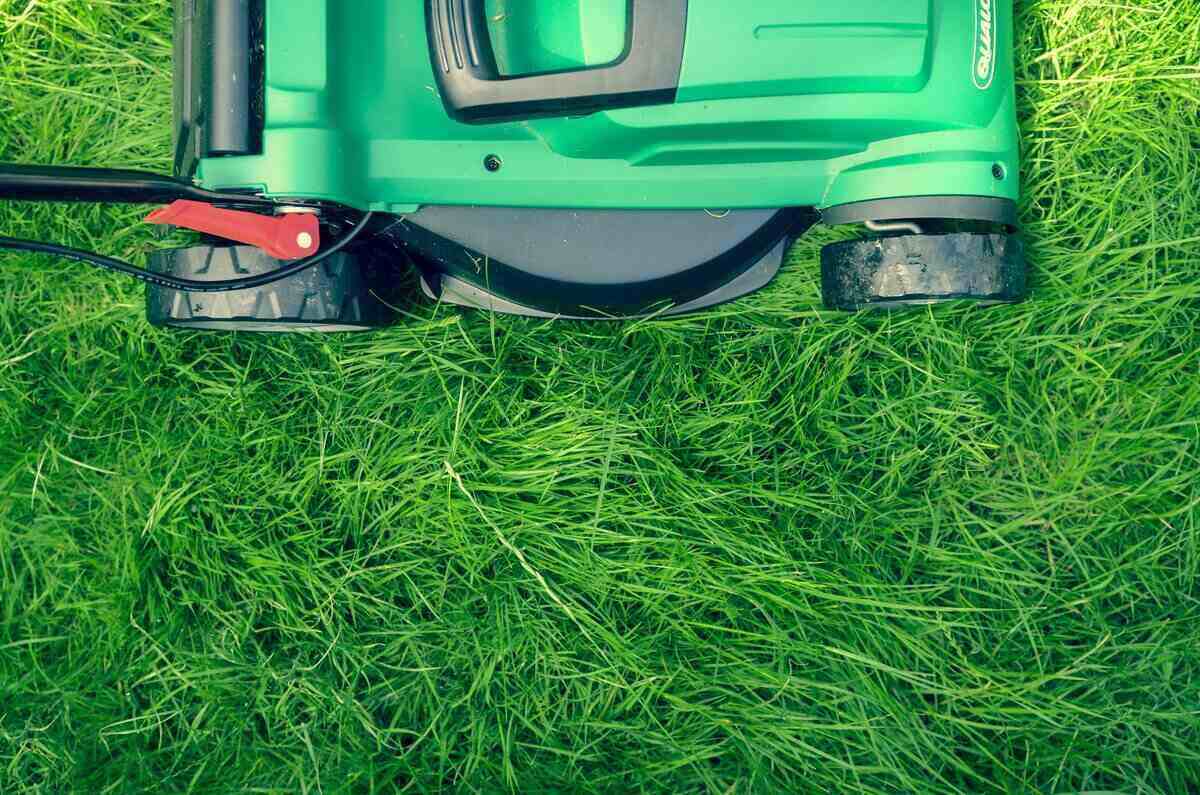
Lawn mowing is an important part of keeping your grass healthy and looking good. It can be the difference between a green expanse or a brown, bland disappointment. We’ll share lawn mowing tips to help you cut your grass the right way.
How you mow, when you mow, and what you mow with will all make a difference in keeping your lawn looking and feeling its best.
In this article:
Mục Lục
Why Mow?
You are doing your lawn a favor when you mow it. Mowing your lawn stimulates its growth. A grass plant’s purpose in life is photosynthesis — that is, pulling in carbon from the air, energy from the sun, and water from the earth to grow roots and blades of grass.
When you cut off the tips of the grass plants, they are stimulated to grow more. The result is a thicker lawn with better roots, which crowds out weeds and makes your turf oh so nice to roll around in and toss the ball on.
But as anyone with parched brown spots, patches of weeds, or scalped grass can attest, a lot can go wrong in the process.
How to Mow a Lawn
“Without regular mowing, even a fine turf quickly becomes just another weed patch,” wrote Richard L. Duble, retired professor and renowned turfgrass specialist for the University of Texas A&M.
But where do you begin? Whether this is your first time behind a mower or you’re a seasoned pro, follow these lawn mowing tips to increase the health and vigor of your lawn and get that gorgeous green look you’ve always wanted.
Sharpen Mower Blades Regularly
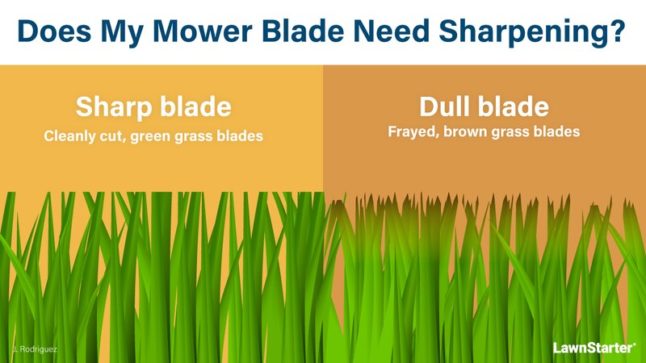
If you can’t remember the last time you sharpened your lawn mower blade, it’s time to do so.
“A dull blade is about the worst thing you can do to a lawn,” says Campbell Vaughn, agriculture and natural resources agent for the University of Georgia-Augusta Richmond County Extension. “When you tear the leaf, it opens it up for diseases to attack it. A clean cut helps it regenerate a lot faster and be a healthier plant in the long run.”
How often you need to get your blade sharpened will depend largely on how many hours of mowing it does. Mowing a large lawn frequently will cause more wear and tear than occasional use on a small patch of turf.
How to know if your blade is dull:
- Check evenness of the cut:
- If the individual blades of grass have been neatly sheared, you’re good.
- If they have an uneven, tatty appearance and torn leaves, it’s time to sharpen the blade.
You can take the mower into a shop or home improvement store to have the blade professionally sharpened, or you can do it yourself. Lawn mower blade sharpening kits cost as little as $10.
- Inspect your blade:
- If there are chips or gaps, it may be time for a new one.
How to replace a lawn mower blade
If you’ve been hesitant to replace your lawn mower blade, relax. This is a beginner-level DIY project that you can accomplish with tools most of us have around the house.
Instructions vary slightly depending on the type of mower you have, so it’s best to follow your user’s manual.
- Disconnect the spark plug boot and remove gas from the tank into a safe storage container.
- Tip the mower on its side with the air filter facing up.
- Wearing gloves, secure the blade with a block of wood or a universal blade removal tool.
- Loosen the blade retaining bolt to remove the blade.
- Install new blade, making sure the center hole aligns with the blade adapter.
- Using a torque wrench tighten the retaining bolt to the proper torque suggested in your user manual.
- Tip back onto its wheels, reattach the spark plug boot, and refill the gas tank.
You’re ready for a clean-cut lawn!
Know When to Mow the Lawn
Ideally, you mow when your lawn needs it. Whether you do it yourself or hire a service, the idea is to schedule your lawn mowing so that it occurs when the grass benefits most from it.
Regularly scheduled weekly mowing may vary depending on a few things:
- Recent fertilization: Your grass will undergo a growth spurt, and you can increase the frequency to prevent excess accumulation of clippings.
- Drought: Set the mowing height higher and reduce your mowing frequency so the grass plants retain more moisture.
- Grass type: Different types of grass have different peak growing seasons.
There are differences in the growth patterns of warm-season and cool-season grass types.
- Warm-season (Southern) grasses such as St. Augustinegrass and Bermudagrass ramp up their growth in the summer, so expect to mow them more frequently then.
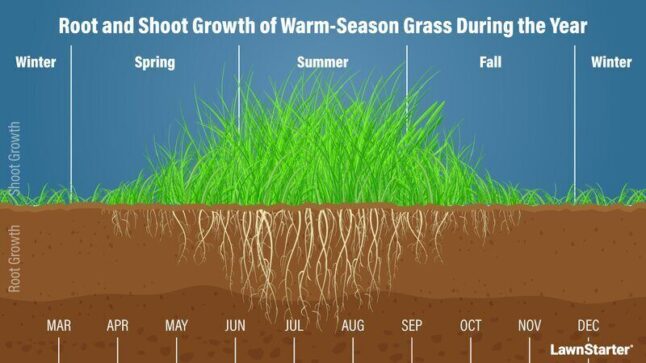
- Cool-season (Northern) grasses: Kentucky bluegrass, turf-type tall fescues, and fine leaf fescues have twin peaks of growth in spring and fall, so that’s when your heaviest mowing workload will be. You can back off on mowing frequency in the summer.
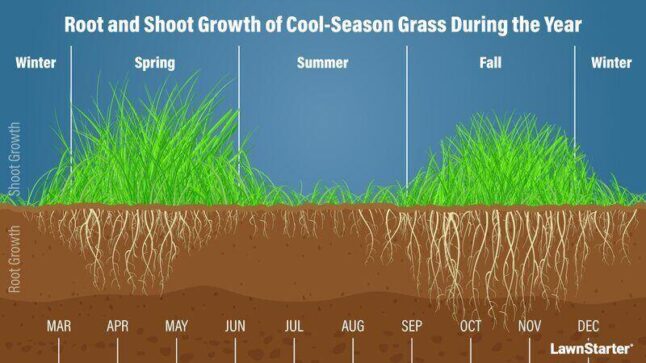
You can cease mowing when grasses go dormant, either due to extended drought or cold. How soon that is will depend on your climate.
- Cool-season grasses can take the cold and usually go dormant in the fall when the soil temperatures fall to 50 degrees Fahrenheit.
- Warm-season grasses generally go dormant around mid to late October.
“During your grass’s growing season, mowing once a week should be plenty,” said Brad Leahy, owner of Blades of Green, a lawn care company that has been cutting Maryland and Northern Virginia lawns for more than 25 years.
Best Time of Day to Mow Your Lawn
When you mow can have an impact on your lawn’s health.
Best times to mow: The pros say mid-morning, between 8 a.m. and 10 a.m., or after 4 p.m. are the best times to mow your lawn.
Worst times to mow: Early morning, between 6 a.m. and 8 a.m. There will still be dew on the grass at this time. The wet dew makes your lawn mower work harder and causes clumps of wet grass to clog the mower and accumulate in your yard. Wait until that dew has dried and then have at it.
In addition, avoid mowing at mid-day — it’s just too hot — and in the evening after 6 p.m. when the grass won’t have time to recover before nightfall.
Mowing Pattern
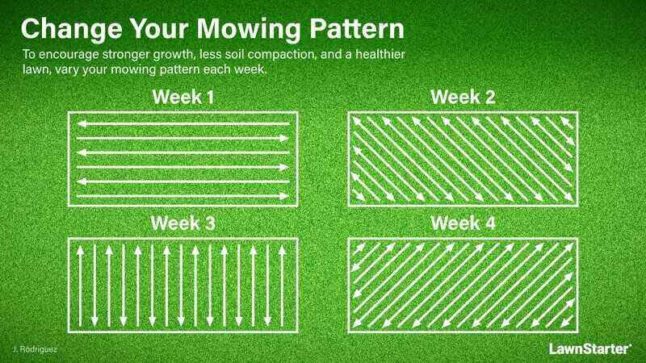
“Once you finish mowing around any features and move on to mowing the open lawn, I suggest homeowners establish a mowing pattern, whether that’s straight rows or circles; again, whatever works best for you and your lawn,” says Leahy.
For the best lawn, it’s better to vary your mowing pattern, especially if your mower is heavy. That way you don’t wear grooves in your yard and you catch the blades of grass that may have bent out of the way the last time.
Proper Height to Cut Grass
The proper height for your grass will depend on its species. See the chart below for details. But over the years, turfgrass specialists have created one important rule:
- The One-Third Rule: Never remove more than one-third of your grass on any cutting.
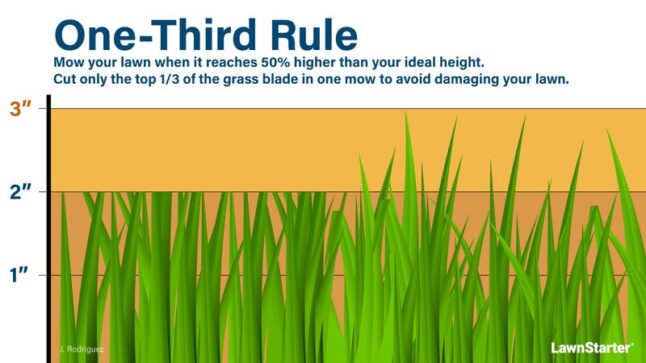
No matter how tempting it is to whack it all down when your lawn is growing wild, don’t do it. Adhere to the one-third rule, and cut your grass down in increments. This will reduce the amount of stress you put on the grass.
Recommended Mowing Height by Grass Type
Grass speciesRecommended mow height (inches) Mow when it reaches this height (inches)
Annual ryegrass1.5 – 22.25 – 3
Bermudagrass (seeded) 1 – 1.51.5 – 2.25
Buffalograss1 – 21.5 – 3
Centipede grass23
Colonial bentgrass0.5 – 10.75 – 1.5
Creeping bentgrass0.5 inch or less0.75 inch or less
Dichondra0.5 – 0.750.75 – 1.125
Hard fescue1.5 – 2.52.25 – 3.75
Hybrid Bermuda0.5 – 1 0.75 – 1.5
Kentucky bluegrass2-33-4.5
Kikuyugrass1 – 1.5 1.5 – 2.25
Perennial ryegrass1.5 – 2.5 2.25 – 3.75
Red fescue1.5 – 2.5 2.25 – 3.75
St. Augustinegrass2.5-33.75-4.5
Tall fescue1.5 – 32.5 – 4
Zoysiagrass0.5 – 10.75 – 1.5
Sources: University of California-Davis Integrated Pest Management program, University of Georgia-Augusta Richmond County Extension
“The one-third rule is critical,” said Vaughn. Virtually all mowers have a height adjustment, so use yours.
How to adjust your lawn mower
Don’t just eyeball it. Here’s how to get an accurate cutting height every time.
- Get out a tape measure and park your mower on a hard, even surface.
- Measure from that surface up to the blade.
- Most lawn mowers adjust the height of the deck with levers on the wheels.
As you adjust the height of the mower, you may find that the highest mower setting is the preferred cutting height.
Grass Clippings: Mulch Them
The standard wisdom has changed in the past few decades about grass clippings. A few decades ago, lawn clippings were thought to contribute to thatching, so the common practice when mowing your lawn was to bag lawn clippings and discard them.
It has since been discovered that mulching — leaving clippings on the lawn — is the better choice. Letting your mower chop the grass blades returns nitrogen to the soil and does not contribute to thatching. It does contribute to weed control and is an organic way to fertilize and maintain a healthy lawn.
Regular lawn mowers do an adequate job of mulching, but mulching mowers have a special blade that chops the grass blades into fine pieces, hastening their decomposition.
Pro Tip: It’s fine to run your mulching blade over leaves to add them to the mulch mix. If the leaves are thick, though, rake them up for leaf removal into a compost pile.
Lawn Mowing Tips
Pablo Solomon says he started mowing lawns for 50 cents a yard with a human-powered push mower when he was a 10-year-old growing up in Houston, where, he said, “the grass grows faster than the national debt.”
Now 71, he is a renowned “green designer” who chooses his grasses carefully. “Each type of grass has its own characteristics that determine when it grows, where it grows, and when it may go dormant according to the climate,” he said.
Over the years, he has developed his own mowing technique, which he still practices on the large lawn surrounding his historic house north of Austin, Texas.
- Check the yard: That’s the first task for Solomon, “Be certain to scout out your lawn before you mow.”
“Remove any rocks, debris, toys, etc., that might damage your mower or that might be thrown by your mower and hurt someone or damage something. A lot of windows are broken by lawn mowers slinging stuff, and a lot of people have gone to the hospital with shrapnel wounds,” Solomon said.
- Dealing with slopes: Different rules for different mowers.
He and other experts advise:
Power mower: You ride up and down the slopes horizontally so that the mower is never tilted to one side.
Push mower: You do the opposite and mow parallel to the contour of the slope.
- Not too close: Don’t get your mower too close to trees, the curb, flower beds, rocks, playground equipment, your shed, or anything else, he said.
That’s what the line trimmers and edgers are for. “By trying to get too close to stuff, you run the risk of damaging the stuff, the mower, and/or yourself,” he said.
If you are using a lawn care professional, make sure you convey your wishes to your service provider.
- Pace yourself: If your lawn is large, break up the job into smaller pieces.
Solomon advises. “I know that people that care about having their lawns perfect can be somewhat neurotic at times. But allow yourself to be a bit less compulsive when you run the risk of a heat stroke or heart attack.”
Leahy agrees. “We always recommend starting at the places that will take the most time: around rocks, shrubs, buildings or other features in your lawn,” he said.
“By doing this at the start, you’re still fresh and willing to take the time to mow these areas carefully and correctly. If you wait till the end, you may rush these parts, potentially damaging your lawn mower.”
Be careful with a mower on newly sodded grass or new lawns grown from seed. The root system of the grass is not very deep, so be gentle by minimizing turns with your mower. Make the turns off the lawn or over pavement or bare soil, where possible.
Caveat: Mowing height recommendations will vary by grass type.
How To Choose The Right Lawn Mower
There are several different types of mowers that you can use in your lawn maintenance. Purchasing the correct mower for your needs really comes down to the size of your yard, your budget, and your personal preference.
Riding mowers are recommended for larger yards, while push mowers can handle small to medium jobs.
- Lot size: A homeowner of a large property with multiple acres requires a different type of lawn mower than a person with a small yard. For this person, a riding lawn mower would be the weapon of choice.
Riding lawn mowers range in price from $600 to $14,000, depending on the power, size, and quality of the machine that a person needs. A large property will also restrict homeowners from using corded electric lawn mowers that require the machine to remain plugged into an outlet.
The standard rule for choosing a lawn mower based on yard size is:
- Yards no larger than one-half acre, stick with a push mower.
- Lawns larger than one-half acre, the homeowner should begin to consider a riding mower, which will save time and energy for the user.
- Greater than three acres, look at upgrading to a zero-turn or garden mower, which will provide better mobility and ease each time the grass needs mowing.
Determine how much you have to mow to choose the best option for you.
- Topography: You must determine if your yard is flat or if there are variations in elevation, including varying hills and valleys.
A riding lawn mower, for example, wouldn’t be a great fit for a yard with steep hills and tight spaces due to the lack of mobility that they provide compared to push mowers. If your lawn is bumpier than you like, you may need to level your lawn.
- Physical fitness: Lawn care is a physical activity that requires a certain level of strength and stamina. This can be offset to an extent with a riding lawn mower, but the individual would then incur a greater cost.
Motorized push lawn mowers are generally a perfect balance between the price (compared to that of riding lawn mowers) and the physical effort needed to propel a nonelectric reel lawn mower that uses only the physical exertion of its user to cut the grass.
A study by Harvard Medical School measured the calories burned by people in different activities, including lawn mowing. A 155-pound person pushing a manual push (reel) mower would burn 198 calories in a half hour — the same caloric output as someone doing a half hour of low-impact aerobics.
Pushing a motorized mower was less strenuous, the study found, burning 162 calories in a half hour — the same as a good half-hour game of badminton.
- Cost: A lawn mower can be an expensive purchase, so know your prices before you buy.
Average cost of a reel mower: $104
Average cost of a walk-behind mower: $363
Average cost of a riding mower: $2,450
Average cost of a robot mower: $1,470
- Personal preference: Personal preferences mean you may choose an electric versus a gas push mower or choose to go completely low-tech with a standard reel mower.
Mowers can also be personalized with features that include a mulching blade that chops up the grass into tiny bits and distributes it across the yard or a grass bag that collects the grass clippings as you go to make for easier disposal.
Be Courteous to Your Neighbors When Mowing
It’s just common courtesy to avoid mowing too late or too early. The Noise Pollution Clearinghouse, a nonprofit organization that fights noise pollution, has enacted a “Good Neighbor Policy.”
Regarding the use of lawn equipment, the policy suggests that people:
- Use a reel mower and rake whenever possible
- Use power lawn and garden equipment between 9 a.m. and 6 p.m.
- Do not use a leaf blower for health and noise reasons.
- Whenever possible, avoid the outdoor use of power tools on Sunday.
- Avoid the use of power lawn equipment if your neighbors are in their yards.
- Establish a schedule for motorized outdoor lawn and garden work with your neighbors (e.g., even number days only).
If courtesy isn’t enough of an incentive for you, be aware that more than 500 local governments have passed noise pollution legislation, violations of which could force you to pay a hefty fine.
To mow with as little noise as possible, electric mowers and reel mowers are a quieter choice than gas mowers.
FAQ: How To Mow Your Lawn The Right Way
Is There a Right or Wrong way to Cut Grass?
Yes. Mowing incorrectly can leave brown patches and scalped grass that can ruin your healthy lawn. Here’s the right way to mow your lawn:
• Follow the One-Third Rule
• Keep mower blades sharp
• Mow mid-morning or late afternoon
• Vary your mowing pattern
• Cut at the proper height
• Leave your clippings on the lawn
How do I Mow Stripes into my Lawn?
Simply bend the grass blades in opposite directions to create that baseball field look in your lawn. With a simple striping kit, you can create checkerboard, diagonal stripes, waves, or any other shape you desire.
Here’s how to mow stripes in your lawn:
• Attach a striping kit to your mower. Striping kits are mini lawn rollers that help the grass blades to bend in the desired direction.
• Start by mowing the entire perimeter of the lawn.
• Look for a straight path or driveway to follow. First stripe should be mowed parallel to this.
• At the end of that stripe, either elevate the mower deck or make a tight turn with your mower to mow the following row.
• If your turn marks are visible, finish by cutting a final strip of grass along the yard’s perimeter to hide them.
What is the Fastest way to Mow my Lawn?
Making the fewest number of turns is the fastest approach to mowing your lawn. According to David’s Lawn Mowing Efficiency Hierarchy, the list of fastest to most-time consuming mowing methods are:
• Spiral: Start from the outside and spiral into the middle. (No 180-degree turns!)
• Long stripes: Mow the long edge — the length of the rectangle — then u-turn, and go back the other way.
• Short stripes: Same as long stripes, but mow across the short side.
• Diagonal stripes: Start at one corner, and go back and forth across the diagonal.
Mow it Yourself? Or Hire a Pro
Your other choice is to forgo the lawn mower purchase and instead hire a professional lawn service. So, if you don’t want to learn the fine art of lawn care, see if we provide service to your area. Finally, make sure to check references and Better Business Bureau ratings for your pro before they mow.
Main Image Credit: Daniel Watson / Unsplash / License
![]()
![]()
Daniel Ray
Daniel Ray is LawnStarter.com’s former editor in chief. He is an award-winning writer and editor who previously was editor in chief of the personal finance websites Bankrate.com and CreditCards.com, but with 30 years of gardening experience, he’s well qualified to help consumers grow a different kind of green. Posts by Daniel Ray
Daniel Ray is LawnStarter.com’s former editor in chief. He is an award-winning writer and editor who previously was editor in chief of the personal finance websites Bankrate.com and CreditCards.com, but with 30 years of gardening experience, he’s well qualified to help consumers grow a different kind of green.















![Toni Kroos là ai? [ sự thật về tiểu sử đầy đủ Toni Kroos ]](https://evbn.org/wp-content/uploads/New-Project-6635-1671934592.jpg)


